Small-Cell Lung Cancer:
If you or a loved one has received a diagnosis of small-cell lung cancer, our comprehensive oncology team of specialists at West Cancer Center & Research Institute will work with you to formulate an individualized treatment plan utilizing the most cutting edge treatments and technology. Our goal is also to provide resources and information to help you better understand and manage your diagnosis.
What is Small Cell Lung Cancer?
These cancer cells are very small, start in the breathing tubes (bronchi) and can grow and spread rapidly (metastasize) to other parts of the body. Only a small percentage (15%) of lung cancer patients have small cell lung cancer. This form of lung cancer is often symptom free and hard to discover in its earliest stages.

Schedule an Appointment
Click here if you would like to schedule an appointment or refer a patient to West Cancer Center.
Schedule and Appointment

Find a Clinical Trial
At West Cancer Center, our patients have advanced access to the therapies of tomorrow – today.
See Clinical Trials

Learn More
To learn more, please click here to visit the National Comprehensive Cancer Network (NCCN®) website.
Learn More

Learn more about how to schedule an appointment or refer a patient to our oncology specialists here at West Cancer Center.





